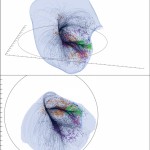W. M. Keck Observatory press release…
Do you know where you live? You probably know your street address and the name of your town, state, and country. But what about your cosmic address — your location among the stars? Thanks to efforts by some astronomers in Hawaii, you can now tell people you live in Laniakea.
Scientists have known for decades that our solar system rests on an outer arm of the Milky Way galaxy. In turn, galaxies are not sprinkled randomly throughout the cosmos; they cluster into groups, which themselves are part of larger groups.

Tully’s team determined Laniakea’s contours using a method similar to the way geographers would map watersheds on Earth. In an article published in the September 2014 issue of Nature, Tully and his co-authors Hélène Courtois, Yehuda Hoffman, and Daniel Pomarède describe how they began by measuring the distance from Earth to more than eight thousand galaxies and observing the galaxies’ movement. From those measurements, they calculated each galaxy’s “peculiar velocity,” or the difference between its observed velocity and the rate at which all galaxies are receding from each other (called the “cosmic expansion”).
Continue reading “Earth and The Milky Way Just Got a Few Trillion New Neighbors”
